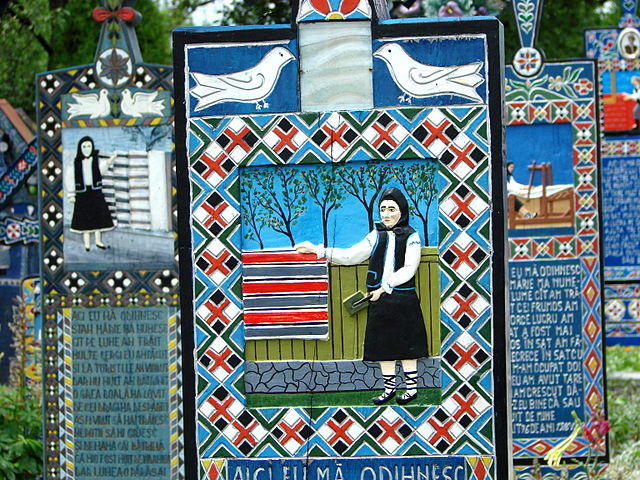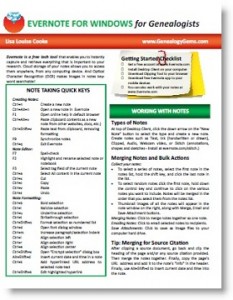by Lisa Cooke | Dec 16, 2014 | 01 What's New, Cemeteries, Humor, Inspiration, Memory Lane

The “Merry Cemetery” Sapanta, Romania. Image credit: “Merry Cemetery – Sapanta – Romania 01”, by Adam Jones (Adam63). Wikimedia Commons image at- http://commons.wikimedia.org/wiki/File:Merry_Cemetery_-_Sapanta_-_Romania_01.jpg#mediaviewer/File:Merry_Cemetery_-_Sapanta_-_Romania_01.jpg.
A gravestone creator in a small town in Romania took his mission seriously to memorialize the dead. But he did in, er, “living color,” so to speak. With plenty of colorful images and even dirty little secrets and gossip carved onto tombstones of the local residents at the “Merry Cemetery.”
As reported in the New York Daily News, the woodcarver responsible for over 1000 gravestones in the “Merry Cemetery” would wander through town, taking notes on people’s quirks and secrets. Some flaws–drinking and carousing among them–are memorialized colorfully on their tombstones. On other stones, you’ll find his sad laments for the untimely passing of a child or the death of an adult by a sad accident.
“There’s no point in hiding secrets in this small town in Maramures, so people’s lives are captured honestly in their epitaphs,” reports the article.
The woodcarver was Stan Ion Patras, who lived from 1908-1977. Conscious of the legacy he was leaving–and perhaps anxious to tell his own story rather than have someone else do it–Patras carved his own tombstone before he passed away. He trained his replacement, who continues to add to the brightly colored crosses.
Here’s another detail I thought was neat: Patras’ folk art was highly symbolic. According to a New York Times article on the cemetery, “The portrait of the deceased is central, surrounded by geometric designs in symbolic colors: yellow for fertility, red for passion, green for life, black for untimely death. The color scheme is keyed to the subject’s life — if, for example, the deceased had many children, yellow carries the design. Some crosses are crowned with white doves representing the soul; a black bird implies a tragic or suspicious end. The background is always blue, the color of hope and freedom.”
What’s the most fascinating cemetery you’ve ever visited? What’s the most memorable epitaph you’ve ever found? Share it on our Genealogy Gems Facebook page!
by Lisa Cooke | Dec 10, 2014 | 01 What's New, Evernote, Organization, Source Citation
Recently Richard wrote in with great questions on using Evernote for family history. “Thank you for ‘reinvigorating’ my interest in my family history,” he says. “I  watched [your Legacy Family Tree webinar] on Evernote twice and I am now a Premium user thanks to the video. I’m following many of your suggestions, but have a few questions.”
watched [your Legacy Family Tree webinar] on Evernote twice and I am now a Premium user thanks to the video. I’m following many of your suggestions, but have a few questions.”
Here’s our Q & A on using Evernote for family history:
Q: “Creating a set of useful tags assumes that in the future you will want to extract data based upon those tags. Since in many cases you don’t have the data yet, and can’t know what you want to retrieve (kind of a “Back to the Future” scenario), do you have any suggestions on specific tags? Here are a couple I’m thinking of using and I’d appreciate your opinion: Census year — Birth year – Death year – Civil Records – Church Records.”
 A: Yes, I provide a list on my Evernote for Genealogists quick reference guide that follows along the lines you are already going (focusing on record types). I recommend keeping tag names simple so there is less clutter in the left hand column of Evernote. i.e. Birth, Census, Death, Immigration, etc. I also tend to have location tags such as states and/or counties in anticipation of opportunities to do research in those areas. If I’m going to make a trip to Randolph County, it would be convenient to access all related notes regardless of family or time frame with one click of a tag.
A: Yes, I provide a list on my Evernote for Genealogists quick reference guide that follows along the lines you are already going (focusing on record types). I recommend keeping tag names simple so there is less clutter in the left hand column of Evernote. i.e. Birth, Census, Death, Immigration, etc. I also tend to have location tags such as states and/or counties in anticipation of opportunities to do research in those areas. If I’m going to make a trip to Randolph County, it would be convenient to access all related notes regardless of family or time frame with one click of a tag.
Originally I created notebooks for each major surname in my tree, but I recommend tags now. I reserve notebooks for high level topics and projects—particularly projects I anticipate wanting to work with others on. It’s very convenient to simply share a notebook. There are five Evernote videos that are part of Premium membership that go in to all the details. You’ll find the list here.
Q: “Do you tag individual surnames in your notes? What about generations, i.e., Grandparents — Great-Grandparents — Great-Great-Grandparents, etc.”
A: I have laid out my organizational strategy in the Genealogy Gems Premium Membership videos “Hard Drive Organization” and have since elaborated on how I apply that method to Evernote in several Premium podcast episodes.
Q: “I noted in your video you do not clip most of your family photos. Do you clip full census sheets?
A: Yes. Anything to do with my research!
Q: I use Family Tree Maker, and subscribe to Ancestry.com. Once you have compiled all these notes, what and how do you include them into your tree?”
A: I cover this in Premium episode 96.
 As you can see, though I cover a lot of Evernote questions on my free Genealogy Gems website, a lot of his more detailed questions are addressed in members-only Premium content. Learn more about Genealogy Gems Premium membership here: all the great online videos and Premium podcast episodes you’ll be able to access for a full YEAR for less than the price of attending a single day at a genealogy conference!
As you can see, though I cover a lot of Evernote questions on my free Genealogy Gems website, a lot of his more detailed questions are addressed in members-only Premium content. Learn more about Genealogy Gems Premium membership here: all the great online videos and Premium podcast episodes you’ll be able to access for a full YEAR for less than the price of attending a single day at a genealogy conference!
Just interested in Evernote right now? Check out this post:
How to Get Started in Evernote, and the Ultimate Evernote Education
by | Nov 3, 2014 | 01 What's New, Family Reunions, History, Humor, Trees
 Here’s a fun online tool that points toward the political leanings of current U.S. residents with your surnames: What’s in a Name?
Here’s a fun online tool that points toward the political leanings of current U.S. residents with your surnames: What’s in a Name?
For example, when I enter my maternal grandfather’s surname, Felix, I find that this surname overwhelming votes Democrat (77%). My father’s surname, McClellan, is evenly split. There’s a cool (but slightly confusing) map that breaks down results by state. Of course I looked at the state breakdowns where my family lives now and in their ancestral home states!
Do political leanings really run in a family? Here’s an interesting article about familial voting patterns (again for the U.S.). Based on your surname results and what you know about your family, would this be a FUN family history conversation to introduce at your next family reunion would it open a can of worms?
Just remember, this isn’t a historical picture of your surname but predicted figures for the next big election. Not everyone with your surname is a relative, and that you likely have lot of relatives from that same surname line who wouldn’t be included because their surnames have changed. There’s also no explanation on this page of where they get their raw numbers or how they calculate their answers. You’d want to check the supporting organizations for party or other bias. So this is JUST for fun! But think about it–what resources would you use to research the politics of your family tree? Obituaries? Newspapers? Interviews with older relatives? Even naming patterns? My husband’s grandfather is named Franklin Delano–I wonder who his parents voted for….
by Lisa Cooke | Oct 14, 2014 | 01 What's New, British, Heirloom, Inspiration, Military, Volunteer, Who Do You Think You Are?

A U.K. news site recently reported a story about an orphaned heirloom World War I medal that is trying to get back home–with help from a retired postal worker.
Terry Lane is a member of a group that searches people’s properties for old artifacts (they get permission!). He discovered the medal in a trash bin in the woods. He cleaned it up enough to tell that it’s a WWI British silver medal with an inscription: “PTE A J Stedman ASC” and a notation that meant he was a supply specialist for Kitchener’s New Army.
Lane contacted an expert researcher who has worked on Who Do You Think You Are? for help. They have determined that the man was likely an Albert J Stedman, who lived in that locale. Lane hopes to track down a descendant to whom he can return the medal.
Do you have any stories of orphaned heirlooms, lost or found? Let us know!
If you like this post….
- Check out this post with advice on how to track down a family to return something.
- Interested in genealogy volunteerism? Click here to read a post on what has replaced that classic do-gooder organization, Random Acts of Genealogical Kindness.
by Lisa Cooke | Oct 9, 2014 | 01 What's New, Google
One of my favorite Google Search Operators is the Tilde (`) which is Google lingo means Synonym. In the past you could add~genealogy to your searches and Google would look for ‘genealogy’, ‘family history’, ‘ancestry’ etc. Unfortunately, it is no more.

Google explained the decision to do away with synonym search this way: “Why? Because too few people were using it to make it worth the time, money, and energy to maintain…Maintaining ALL of the synonyms takes real time and costs us real money. Supporting this operator also increases the complexity of the code base.”
So now, more than ever, it’s important to choose your keywords wisely and think like the person who may be posting information you are looking for. You may think train history, but experts on the subject may be using railroad or locomotive as they write on their website. The good news is you can include all the options in your search query.
Recommended Viewing:
Genealogy Gems Premium Video: Ultimate Google Search Strategies
Recommended Reading:
Things may change online,
but Genealogy Gems will never change:
We’re here to help!


 watched [
watched [







